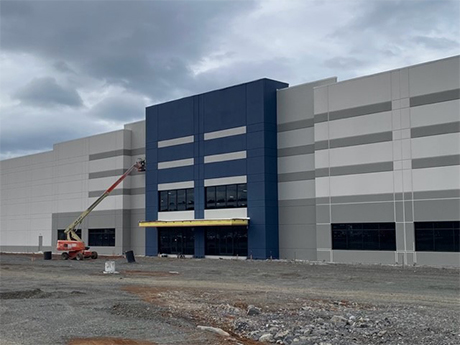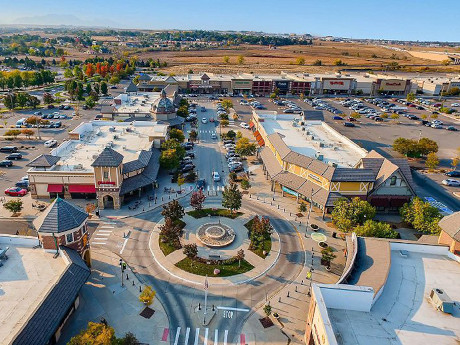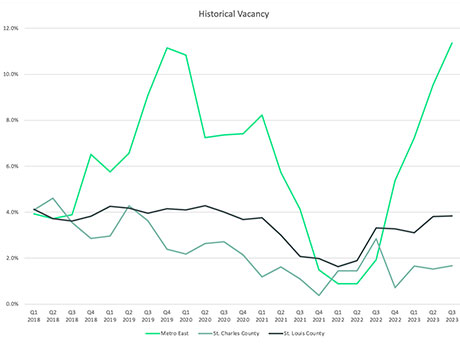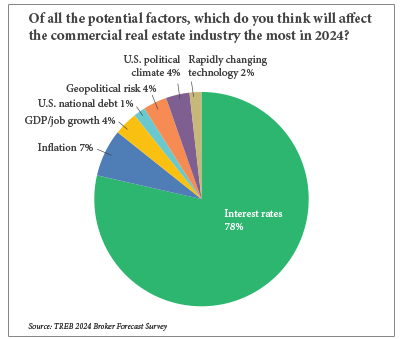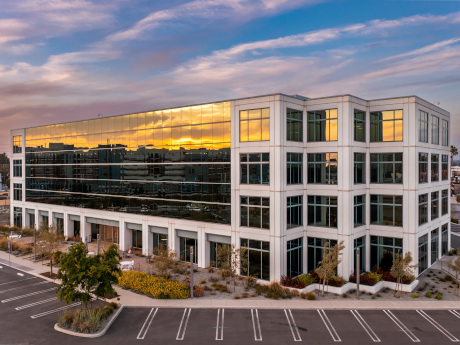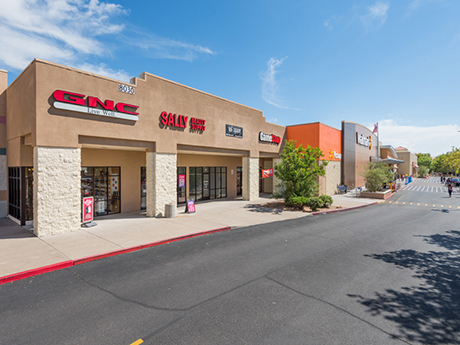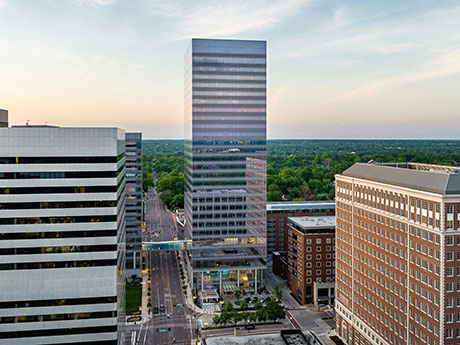While there has been a discernible dip in the volume of industrial leasing activity occurring in the greater Baltimore metropolitan area this past year, optimism remains high among owners and investors of this asset class given the diminishing volume of new product under construction, the still low 7.4 percent overall vacancy rate, record high — yet stabilizing — average asking rents of $10.54 per square foot net and the fact that 10 million people are not likely to soon move away from the Baltimore-Washington, D.C. corridor, the fourth-largest combined metropolitan statistical area in the country. Oh yes, spirits remain high following the Baltimore Orioles’ underdog ride to the top of the American East standings this summer. Never underestimate the power of a professional sports franchise to energize an entire region. The metro Baltimore industrial market consists of more than 3,600 buildings, totaling more than 266 million square feet of space that includes flex and industrial Class A, B and C buildings. Year-to-date, the market has yielded negative absorption of approximately 1 million square feet of space, including nearly 300,000 square feet this past quarter. The bad news of GXO Logistics shuttering a 571,000-square-foot distribution center in Harford County and laying …
Market Reports
— By Tami Lord, Senior Vice President, SRS Real Estate Partners — No longer the Cowtown of ages past, Denver has developed into an economically diverse, midsized city as demonstrated by both the residential and business growth over the last decade. Major companies now include Denver on their target list for potential headquarters, regional hubs, and distribution locations. Compared to the coastal markets, Denver is more affordable and offers a very desirable quality of life for employees, helping to put Denver on the short list. The pandemic only increased Denver’s growth trajectory. All of a sudden, people were able to maintain their current employment while living in a setting known for over 300 days of sun annually with easy access to hiking, skiing, biking, camping…the list goes on. The population growth has spurred rising housing and land prices. Coupled with rising construction costs, increasing real estate taxes, long permitting times and a tight employment market, traditional retail development has slowed. The lack of significant new development has pushed retail vacancy to a near-record low of 4.1 percent across the metro, according to data from CoStar. Many downtown retail markets across the country have been hit with higher vacancy rates in …
By Matt Hrubes and Joshua Allen, CBRE St. Louis is located at the crossroads of the U.S. at the intersection of I-55 (north/south) and I-70 (east/west), making it a prime location for industrial real estate users and developers alike. The Greater St. Louis area is separated by the Mississippi and Missouri rivers, giving it a natural division of industrial submarkets. Each side of the Mississippi River tells a different story as it relates to industrial real estate. Metro East To the east of the Mississippi River is the Metro East industrial submarket, which was the first in the area to offer real estate tax abatement, resulting in larger industrial developments ranging in size from 500,000 square feet to over 1 million square feet. Over the last decade, this area has seen some of the largest speculative developments in the region from national developers such as Panattoni, NorthPoint and Exeter, as well as local developers like TriStar. Absorption had been at all-time highs with groups like Amazon, World Wide Technology, Geodis, Sam’s Club, P&G and Tesla leasing space as buildings were being completed. That is, until 2023 when a wave of space became available either through sublease, speculative development completions or …
By Taylor Williams For the last several years, as COVID-19, inflation and interest rate hikes have chronologically rocked the commercial real estate industry, the term “dry powder” has increasingly factored into investment discussions. While the term generally refers to cash or capital that is parked on the sidelines, 2024 could well be the year for its deployment. There are several basic reasons for endorsing this notion. First, at its December meeting, the Federal Reserve signaled that it would cut rates three times this year, which should theoretically make debt financing more accessible and less expensive — though the extent of that depends on the magnitude of the reductions. Second, as evidenced by the stock market tear following that announcement, investors are itching to deploy capital and will rally around just about any reason to do so, proven or not. Third, there is roughly $537 billion in commercial real estate loans that will mature next year, according to New York City-based Trepp. This staggering volume of impending maturities in a high-interest-rate environment all but assures that some assets will be forced into sales, whether by owners pre-default or lenders post-default. And finally, the 10-year Treasury yield — the benchmark rate against …
— By Robert Ritschel and Andrew Herron, Senior Vice Presidents, The Saywitz Company — The industrial sector for Orange County commercial real estate continues to be one of the strongest in the country. Vacancy rates in Orange County for industrial space remain at approximately 2 percent. What this means for tenants out in the marketplace is a continued struggle to find viable space. When combining limited availability with the fact that some of the buildings are older or obsolete, or may have lower ceiling height or reduced power, this makes the challenge even more difficult. With that said, we have seen the sales prices for industrial space level off and we have also now, for the first time in the past several years, begun to see landlords offer free rent and move-in concessions, and come off of their asking prices. The days of five or 10 different tenants looking at one available space in the marketplace seem to be over, and those with good credit looking to sign long-term leases clearly stand out from the mom-and-pop operator that may be looking to sign a short-term lease. Landlords on the industrial side appear to be much more conscious of the changing …
The Washington, D.C., metro area, known for its steady and stable economic foundation, stands at the forefront of a transformative period in the U.S. commercial real estate market. Amid the backdrop of an evolving macroeconomic market, it’s essential to recognize the adaptability and resilience of the metro D.C. area’s multifamily market. While recent capital market fluctuations continue to impact asset pricing across multiple sectors, the region’s fundamentals and property level performance have remained strong. According to Berkadia’s third-quarter multifamily market report, rent is up 3.6 percent in the District. Many properties are experiencing strong rent growth, which is anticipated to continue as there is a complete lack of future supply and the bulk of the apartment supply has delivered and is currently in lease-up. While some regions have headwinds that are cause for some investor caution, particularly regarding regulatory concerns, other areas like Northern Virginia are capturing significant interest from buyers and showcasing the region’s ability to still command buyer demand. This is, in many ways, the recurring narrative for the D.C. metro region: resilience supported by concrete fundamentals. Strong foundation In the D.C. metro area, the decline in supply is highly likely to continue to drive a noteworthy increase …
— By Anthony Johnson, President, Pegasus Group and Western Regional Director, X Team Retail Advisors; and AJ Johnson, Associate Broker, Pegasus Group — Looking back on the Albuquerque retail market for 2022 and 2023, I have to say that 2022 was the height of our boom in terms of the sale/lease of shopping center and freestanding pad sales, built-to-suit opportunities and redevelopment opportunities. The top consumers of these product types were chicken (QSR), coffee, car washes and cannabis, or as we affectionately called them, the “Four C’s.” Due to the sheer amount of activity in the pad user market, underutilized was a key word during this time. We saw vacant pad sites that were once considered unleasable or unsellable, perking the interest of investors, tenants and developers. By 2022 the negative effects of the pandemic had subsided, which resulted in the most robust year we’ve ever seen in terms of pad sales/leases. I’ve never seen anything like it. It was like a crescendo… and then, the “music” stopped. It was February of 2023 when the music started to get fainter. By August 2023, the music stopped, and now we’re seeing the aftermath of this. Meaning, many of the pad sites …
By Nick Fiquette, Sansone Group Lingering effects of COVID-19 In the aftermath of the global pandemic, the St. Louis real estate market finds itself at a crossroads, continuing to see the persistent impacts of COVID-19. Corporate strategies are evolving as companies evaluate their real estate footprints to accommodate the changing work environment and desires of employees. As lease expirations loom, businesses are engaged in a delicate dance of evaluating their physical space needs. The pendulum of work-from-home policies, initially adopted to streamline footprints, appears to be swinging back. Recently, Edward Jones listed a 227,000-square-foot Class A building that it owns on the market for lease and is planning on occupying it instead. This example could serve as a positive indicator for the future of the office market. The market is transforming as companies look to accommodate employee demands, prioritizing safe, walkable areas and amenity-rich buildings. This shift is particularly evident in the struggle faced by commodity real estate, as businesses increasingly gravitate toward locations that contribute positively to the employee experience. As a result, investors are remaining cautious about purchasing office assets due to surging interest rates and uncertainties surrounding the future of the office market. Corporate giants reevaluate real …
By Taylor Williams The Houston industrial market has generally performed quite well over the past few years, even as a global pandemic, record inflation and hard-hitting interest rate hikes have rocked the commercial real estate industry as a whole. Demand for industrial space has held firm due to rebounding energy prices and expansions in infrastructure and traffic at Port Houston, as well as organic population growth and economic diversification that has elevated the market’s role as a distribution hub. According to data from CBRE, the market has a 6 percent vacancy rate and posted 5.1 million square feet of positive net absorption through the first three quarters of 2023. The volume of new construction was on track to outpace absorption in 2023 when the report was released. But that was not the case in 2021 and 2022, years in which net absorption equaled and exceeded 7 million square feet, respectively. New deliveries totaled approximately 5.6 million and 5.4 million square feet in each of those years, driven not only by the aforementioned factors but also by a temporary uptick in demand for e-commerce services in the wake of the pandemic. In any market or asset class, when absorption exceeds supply …
— By Jeff Lefko, Executive Vice President, Hanley Investment Group Real Estate Advisors — Hanley Investment Group is expanding and opening its newest office in San Diego in early 2024. San Diego, the eighth most populous city and the fifth largest county in the United States, ranks second only to Los Angeles County in California, boasting a population nearing 3.28 million. With a substantial GDP of $206 billion, San Diego holds the 17th largest metropolitan area position in the U.S. and the fourth largest in California. The city’s economy thrives on defense, tourism, international trade and research/manufacturing sectors. Notably, in 2022, San Diego experienced an 8 percent growth in life science employment, reinforcing its position as a premier life science research destination. Attracting 28.8 million annual visitors, it stands as a prominent U.S. travel destination, generating approximately $13.6 billion in yearly spending and employing 214,000 San Diegans directly and indirectly. San Diego’s robust economy, diverse population, quality education, and prime location render it a desirable hub for commercial retail investment. The business-friendly climate further enhances its allure, while the limited supply of new retail construction helps maintain stable real estate fundamentals. The changing economy and rising interest rates have caused …


